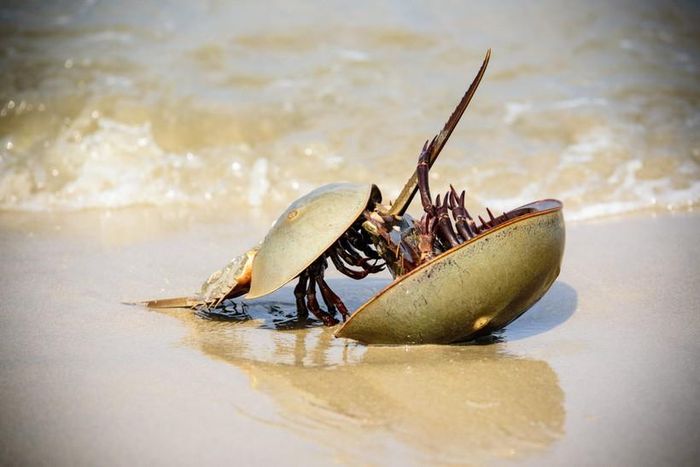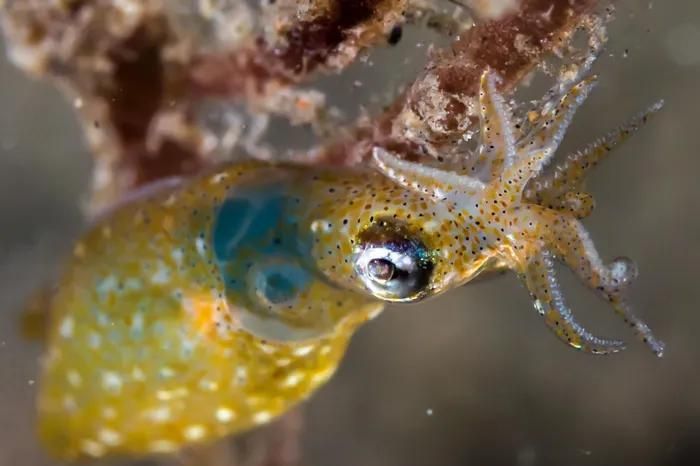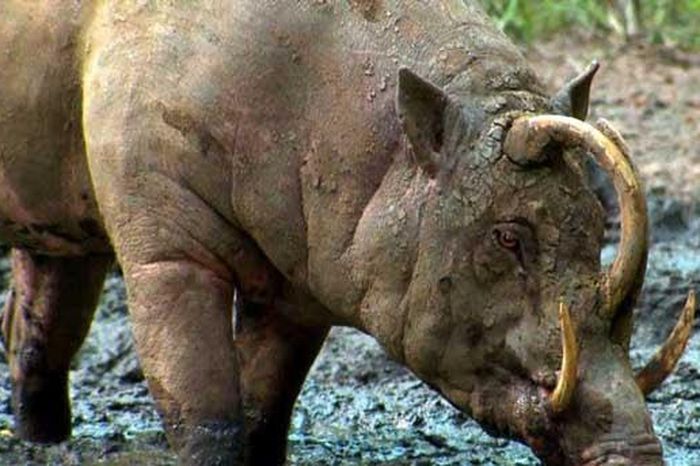5 living 'fossils' on Earth

The mystery of why some species can overcome evolutionary history is still a big question for humanity.
Horseshoe crab
On beaches stretching from the Atlantic Ocean, Maine to the Gulf of Mexico, thousands of opaque brown seashells appear, signaling the breeding season of horseshoe crabs. The behavior of horseshoe crabs going ashore to lay eggs has been going on for millions of years. Horseshoe crabs have existed since the Ordovician period, 488 - 443 million years ago.
Horseshoe crabs are primitive arthropods that have roamed sandy ocean floors since the Paleozoic Era (about 540 – 248 million years ago). They lived at the same time as many long-extinct prehistoric animals such as Trilobites, Orthoceras.
Despite its name, horseshoe crabs are not part of the crab family. They are arthropods and have many similarities with spiders and scorpions. Having survived multiple mass extinctions and ice ages, they thrived as many marine life was wiped out. Their survival is due to their ability to withstand many different environmental conditions such as salt water, fresh water, and low oxygen.
Today, horseshoe crabs are used in biomedical laboratories. Their blood is blue and is one of the most expensive resources in the world. In the blood of horseshoe crabs, there is the compound Limulus amebocyte lysate (LAL), the only coagulant required by the US Food and Drug Administration (FDA) for vaccine safety tests. .
Tuatara
The Tuatara is a slow-moving, 'living fossil' reptile found only in New Zealand. They are the surviving individuals of an ancient reptile order, named Rhynchocephalia, belonging to the order Sphenodontia, shaped like lizards.
Tuatara's ancestors lived at the same time as dinosaurs 225 million years ago. Previously, all fossils of Sphenodontia reptiles were fragmented, including isolated jaws and teeth.
Until 2022, when scientists discovered an almost complete fossil of N.Sani, belonging to the order Sphenodontia. With an almost completely articulated skeleton and jaw structure, this discovery shows that the body characteristics of modern Tuatara are virtually unchanged compared to 190 million years ago.
Nautilus
Nautilus appeared on Earth 400 - 500 million years ago during the Upper Cambrian period. Today, they look very little changed from their known fossil ancestors. This creature is called a snail because it has a large shell, up to 20 cm in diameter, but it is a cephalopod like a squid or an octopus.
Nautilus snails usually live in deep waters, hundreds of meters above the sea surface. They do not cling to rocks but have the ability to 'swim'. Every time they want to float, they will spray water out of the air chambers inside their bodies from a duct using a jet mechanism.
Nautilus can live with almost zero oxygen and weeks without food. Their outer shell is very tough and difficult to break to protect the body inside. Despite its extremely long lifespan, the nautilus's life is constantly threatened by illegal human exploitation activities.
Nautilus shells are often crafted into feng shui items and handicrafts at expensive prices. In 2018, the animal was listed as threatened creatures under the Endangered Species Act in the US.
Coelacanth fish
Coelacanths are found in the waters off East Africa. They lived from the Devonian period and were considered extinct along with the dinosaurs until humans accidentally discovered coelacanths off the coast of South Africa in 1938.
Since the 1990s, geneticists have noticed that the genome of the African coelacanth is rapidly evolving. Despite this change, modern coelacanths still retain a similar shape to their ancestors known through fossils.
Coelacanths spend all day hidden in burrows and only come out at night to feed. They have eight fins, a sturdy body and weigh up to 90kg. It is the only known living animal to have joints in its skull, almost completely separating the front and back halves of the skull from the inside. Scientists believe that coelacanths are an important link in understanding the process of fish evolving into land creatures.
Ginkgo
Remains of ginkgo trees were found from the Permian period 270 million years ago. Growing alongside ferns and primeval sesame, they provided shade for dinosaurs, inspired Song Dynasty poets in China and survived the atomic bombing of Hiroshima, Japan, in 1945.
Ginkgo biloba, scientific name Ginkgo biloba, belongs to the gymnosperm group, meaning it has seeds exposed on the outside. This plant once flourished on most continents until it declined during the Pleistocene ice age due to climate instability. Currently, some populations of ginkgo trees are still scattered in Eastern and Southern China.
These 'living fossils' are descendants of ancient creatures and look almost identical to fossils of their ancestors from hundreds of millions of years ago. However, the term 'living fossil' is not really accurate. Although 'living fossils' look similar to their ancestors, their DNA has changed and gone through many evolutionary cycles
You should read it
- Millions of red 'dyed' crabs on the island of Australia
- Why do rivers never flow in a straight line but like to twist?
- The scorpion of freshwater crab war, the battle of the couples
- Australian man borrowed crab claws to open the cap of beer bottle
- Unexpectedly discover the new unique hermit crab in South Africa
- Top 10 most beautiful animals in the world
- Selecting the right time, rays easily cut giant spider meat
- Listed 10 most picturesque but dangerous waterways in the world
May be interested
- The second time the ancient fossil '3 in 1' was discovered
 the fossil kept intact the history of a prehistoric war: a small insect inside the lizard, and the lizard was in the belly of a snake.
the fossil kept intact the history of a prehistoric war: a small insect inside the lizard, and the lizard was in the belly of a snake. - Discovering another 'super Earth' can appear to live only 21 light-years away
 this super earth is 2.8 times more massive than the earth, 21 light-years away. this can be a rocky planet and cool enough to maintain liquid water, a condition for life.
this super earth is 2.8 times more massive than the earth, 21 light-years away. this can be a rocky planet and cool enough to maintain liquid water, a condition for life. - The most remote and least-populated places on Earth
 on earth there are many remote and remote areas, located in a special position that is difficult to conquer with very few people living. to set foot in those places, it takes many days to move.
on earth there are many remote and remote areas, located in a special position that is difficult to conquer with very few people living. to set foot in those places, it takes many days to move. - The rare giant 'living fossil' salamander stuck two years in the sewer line
 a rare and precious giant salamander belonging to a group of extremely endangered animals is found trapped inside a sewer at a resident's home in wuhan, china. most likely the salamander has been in it for two years.
a rare and precious giant salamander belonging to a group of extremely endangered animals is found trapped inside a sewer at a resident's home in wuhan, china. most likely the salamander has been in it for two years. - These tiny creatures crossed the 384,400km route from the earth and are landing on the moon
 the beresheet spacecraft brought one of earth's toughest living creatures to the moon.
the beresheet spacecraft brought one of earth's toughest living creatures to the moon. - How many animals have ever existed on Earth?
 there are about 8 billion people living in the world, only a small fraction of the number of people who have ever existed, and this number is still very small compared to the number of animals that have ever lived on earth.
there are about 8 billion people living in the world, only a small fraction of the number of people who have ever existed, and this number is still very small compared to the number of animals that have ever lived on earth. - The new hypothesis about Snowball Earth and how the earth freezes hundreds of millions of years ago
 researchers at harvard university have changed the way we think about the largest ice age event on earth, snowball earth. this video will show you how the earth froze according to this hypothesis.
researchers at harvard university have changed the way we think about the largest ice age event on earth, snowball earth. this video will show you how the earth froze according to this hypothesis. - The end of the Earth actually happened about 250 million years ago
 known as the permian-triassic mass extinction event – or the great extinction – it was the largest recorded catastrophe in our planet's past 539 million years.
known as the permian-triassic mass extinction event – or the great extinction – it was the largest recorded catastrophe in our planet's past 539 million years. - 30 tips to help you live simply
 simple living is not as difficult as you think.
simple living is not as difficult as you think. - 10+ samples of beautiful and simple living room furniture
 when choosing beautiful wooden furniture for the living room, it is necessary to rely on the living room area, living room design style ... to choose a harmonious living room furniture.
when choosing beautiful wooden furniture for the living room, it is necessary to rely on the living room area, living room design style ... to choose a harmonious living room furniture.










 Unique new species of squid, super small 1cm, hunts by sitting still
Unique new species of squid, super small 1cm, hunts by sitting still Top strange animals become their own natural enemies
Top strange animals become their own natural enemies Rare fish species live in the 'devil's cave', the number of which can be counted on the fingers of one hand
Rare fish species live in the 'devil's cave', the number of which can be counted on the fingers of one hand Close-up of a mantis capturing and killing a hummingbird with lightning speed
Close-up of a mantis capturing and killing a hummingbird with lightning speed 30 hornets massacred 30,000 bees in 3 hours
30 hornets massacred 30,000 bees in 3 hours The Lion King's worst hunting failure made everyone laugh
The Lion King's worst hunting failure made everyone laugh